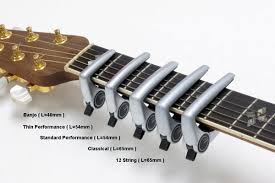
Guitar player, love your capo! And learn to use it. It is one of the most valuable tools a guitarists has.
A capo is useful for
- Playing simple chords in a difficult key.
- Changing the sound of chords. This is important for when two guitars are playing together, because if one guitar uses a capo to play the chords in a different position, it can help the guitars to sound more distinct. You can also use it to "lighten" the sound of the guitar by playing the chords in positions higher up the neck.
The key to all of this is to learn the notes on your neck and learn your open chord shapes, and learn where the capo must go to play various chords. For instance, you need to know that placing the capo behind the 3rd fret and using the chords from the key of G (G, C, D, Am, Em) you will be playing in Bb. This is because your root note is now at the 6th fret on the low E, which is Bb.
Similarly, if you have the capo behind the 5th fret and you use the same chords, you will be playing in C. And if you use the capo behind the 4th fret and use the chords from the key of D (D, G, A, Bm, Em) you will be playing in the key of F#.
This does take learning, there are no shortcuts. Perhaps the best advice is to start thinking about the chords in songs in terms of their scale degrees instead of just their names. So in G, G=I, Am=ii, Bm=iii, C=IV, D=V, Em=vi and F#m=vii. Try and work out how chords in other keys relate to each other like this, and you will begin to become a musical demon! Then it becomes easier to 'translate' a chord to a different capo position.
Remember also that the capo functions exactly like your guitar's nut. In order for it to work properly it must be as close as possible behind the appropriate fret so that the strings break hard over the metal of the fret.
Troubleshoot:
- Setting the capo too far back from the fret will make the strings buzz
- Setting the capo skew will make the guitar sound out of tune
- A capo that is too tight will pull the strings out of tune, a capo that is too loose will make the strings buzz. If you can adjust the tension of your capo then great, otherwise it's time to go shopping.
- If you get all the above right and the guitar is still buzzing, sounding out of tune, etc., it's time to take it to the shop for a service.
Lastly, don't buy a rubbish capo. The best ones are by Shubb (http://www.shubb.com/), but Dunlop and Kyser also make great capos that are quick and easy to put on and take off, and can be clipped the headstock when not in use. The only problem with these is that they pull the strings slightly sideways because of the clamp action. (My favourite is the Dunlop Trigger capo http://www.jimdunlop.com/index.php?page=products/pip&id=67&pmh=products/capos)
If all of this is a bit complicated, never fear! Perhaps a video will help... watch this space!







No comments:
Post a Comment